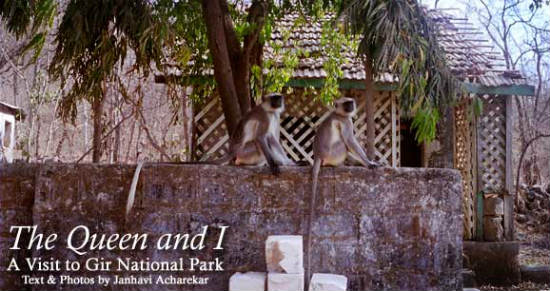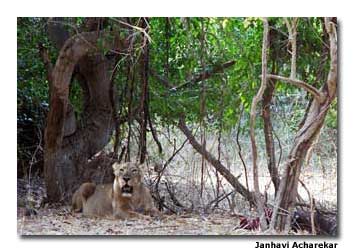

Lions are the stuff of African safaris and National Geographic, of Aesop’s fables and Disney, but I never imagined that I would meet one up close.
Two friends and I set out on a four-day trip to the Gir Forest National Park or Sasan Gir as it is also known, in the western Indian state of Gujarat. It is the last remaining home of the Asiatic lion, who once roamed an area from Greece to India through Persia. Today, there are only about 300 animals left living in a sanctuary.
My friends, both journalists, were to cover the evacuation of the Maldharis, a tribe of cowherders that has found itself in the midst of a controversy. The relationship between the lions and the Maldharis goes back more than half a century. The tribe’s buffaloes are ready prey to the big cats that are growing too lazy to hunt deer. The Indian government pays compensation to the tribe for every buffalo killed by a lion, but it now believes that the buffaloes are eating into the habitat of many forest animals.
The government has now offered the Maldharis land outside the forest. The tribesmen are divided over the issue, though. Some say that the Maldharis are cattle herders, not farmers, and cannot live outside the forest. But the lions cannot satisfy their hunger with deer alone — they are dependent on the buffalo for food. The locals believe the Maldharis are an integral part of the ecosystem. If they go, so will the lions. It is an issue with no easy answer.
Before either one disappeared, I set out with my friends to visit Gir National Forest Park. I was skeptical that I would really see a lion — because of my previous unsuccessful trips to other forest reserves. But I packed my camera anyway, hoping that the much celebrated king of beasts would not disappoint.
Gir National Forest, established in 1965, is spread over a sprawling 545 square miles (1412 km²), of which the National Park only stakes claim to a small part of the area. It is 40 miles (65 km) southeast from the historic town of Junagadh on the southernmost tip of the Kathiawar Penisula. We decided to visit the imposing 15th century Junagadh Fort.
The term “Junagad” really means “old fort,” and the town derives its name from the presence of the fort believed to have been built by Chandragupta Maurya in 319 BC. It was rediscovered and rebuilt by Muslim conquerors in 976 AD. It has withstood several sieges and parts of it were rebuilt as it was passed on from one ruler to another. The actual name of the fort is Uparkot fort but because it lies in the town of Junagadh, it is simply referred to as Junagadh fort. Here, we also met our driver and guide for the trip to Gir National Park. Bhagirath, the son of a former forest guard, knows the forest as well as his own backyard.
We set out at dawn the next morning in an open vehicle called the Gypsy. The monsoon season had not yet begun and the forest was bare. The greens had dulled to a uniform shade of arid brown, relieved occasionally by the plaster whites of gum trees and the bright reds of the “flame-of-the-forest,” an up to 40 feet (12 m) tree that is covered with a riot of orange and vermilion flowers for three months of the year.
This baren canvas would make it far easier to spot the animals. No sooner had we entered the Reserve than we were welcomed by peacocks and chital deer. There was a nilgai, a large, long-legged antelope and small sambar deer. A shock of birds including the rare ibis took off in front of our vehicle. We saw deer with suckling calves, gazelles with locked antlers and several wild boars.
Just when I had admitted to myself that this was more than I had bargained for, we heard the warning cry of a langur, a slender, long-tailed Asian monkey who was indicating a leopard in the vicinity. A sliver of yellow darted across the path. However, after four hours in the jungle, a few pugmarks and false alarms later, we still had not seen a trace of a lion.
Although our guide Bhagirath advised us against it, we insisted on driving out of the Reserve and to Tulsi Shyam, a sleepy hamlet in the unprotected forest, also known for a temple and hot springs. We had been told there had been a few sightings, but the only feline creature we spotted was an unsuspecting jungle cat, its eyes flashing in the headlight of our vehicle. Reluctantly, we returned to the Reserve.
A forest guard was to escort us the following morning as we set about our task with renewed determination. There had been a sighting the previous evening on the very route we now took — a lioness and cubs. Bhagirath and the guard fell silent, and as the engine was turned off, we heard a deer call — a signal, we were informed that there was a lion in the neighborhood. We waited in silence, but only caught a glimpse of the occasional cattle herder on his lonely trek through the forest. Acting on a tip from a passing forest official, our guides took us deeper into the forest.
On foot, we clambered down to join our trackers. At that moment we were taken by surprise, a beautiful autumn-gold lioness stood at a distance of barely 10 feet (3 m) away. Having lazily sized us up, she gracefully proceeded to a better spot so as to get a ringside view of us. She preened for us, yawned at us, and then dismissed us. We were awed into immobility, inching forward slowly to record a life-changing experience. To be able to see a full-grown 300 pound (136 kg) lioness, backlit by the sun on a crimson bed of flame-of-the-forest petals was humbling, to say the very least.
We spent the afternoon with Murad. A tracker for more than two decades, he works for the Reserve, and closely follows the movements of the big cats, having the bearing and agility of a cat himself. He has conducted numerous rescue operations and was himself mauled by a leopard. He is quite a celebrity out here and is mentioned in more than a few books.
Murad continues to aid research on the Asiatic lion. His simple village home is adorned with photographs of himself with the lions, in younger days. His father, too, was a forest guard and Murad has roamed the forest since he was five. When asked if his children will keep the family tradition alive and become trackers themselves he laughed, “I doubt it. My son is afraid of barking dogs.”
With Murad’s help, we were lucky twice. Our evening drive through the forest took us to a lioness, protecting her recent kill — a wild boar. She snatched glances at us from below a tropical fig tree, called a banyan, even as she kept an eye on the circling vultures above. On the way back, as we craned our necks to get a closer look at a crouching panther, we were confronted by yet another lioness. The guard identified her as the same one we spotted earlier that morning.

The following day, during my last ride through the forest, we crossed streams to visit a ness (a community dwelling of the Maldhari tribe.) A wedding had just taken place and the walls were covered with folk art. Outside, near-domesticated peacocks, bulbuls (a tropical songbird) and a red-wattled lapwing (a wading bird) stared at us in curiosity. On the way back to the sanctuary I hoped to see a male lion, but realized that I was asking for too much. There is an old jungle saying — to see the king, you must be granted audience. I was lucky enough to meet the queen.
If You Go
Getting there
Gir National Forest Park is located in Sasan Gir, the state of Gujarat in western India on the Arabian Sea. The nearest airport to the park is Kashod, 43 miles (70 km) away and the closest rail stations are in Junagadh (36 miles or 58 km) and Veraval (26 miles or 42 km).
While the Gir National Park is open to visitors throughout the year, November to June is a good time to visit before the monsoon season starts.
Sinh Sadan Guest House — forest department guesthouse built by the Nawab of Junagadh in 1911.
++ 91 – 2877- 285540
Maneland Jungle Lodge
++ 91 – 2877- 285555
++ 91 – 2877- 285507 (fax)
The Gir Lodge (run by the Taj group of hotels)
++ 91 – 2877 285521/285501-04
++ 91 – 2877 285528 (fax)
India Ministry of Tourism
www.tourismofindia.com
Asiatic Lion Information Center
www.asiatic-lion.org/news.html
Tiger Trails Tours
www.tigertrails.co.uk/sasan-gir.html
- How to Renew a US Passport Quickly and Affordably - April 19, 2024
- 6 Reasons to Visit Portland, Maine (+ Travel Tips) - April 18, 2024
- Cruising with Discovery Princess on the Mexican Riviera - March 30, 2024
